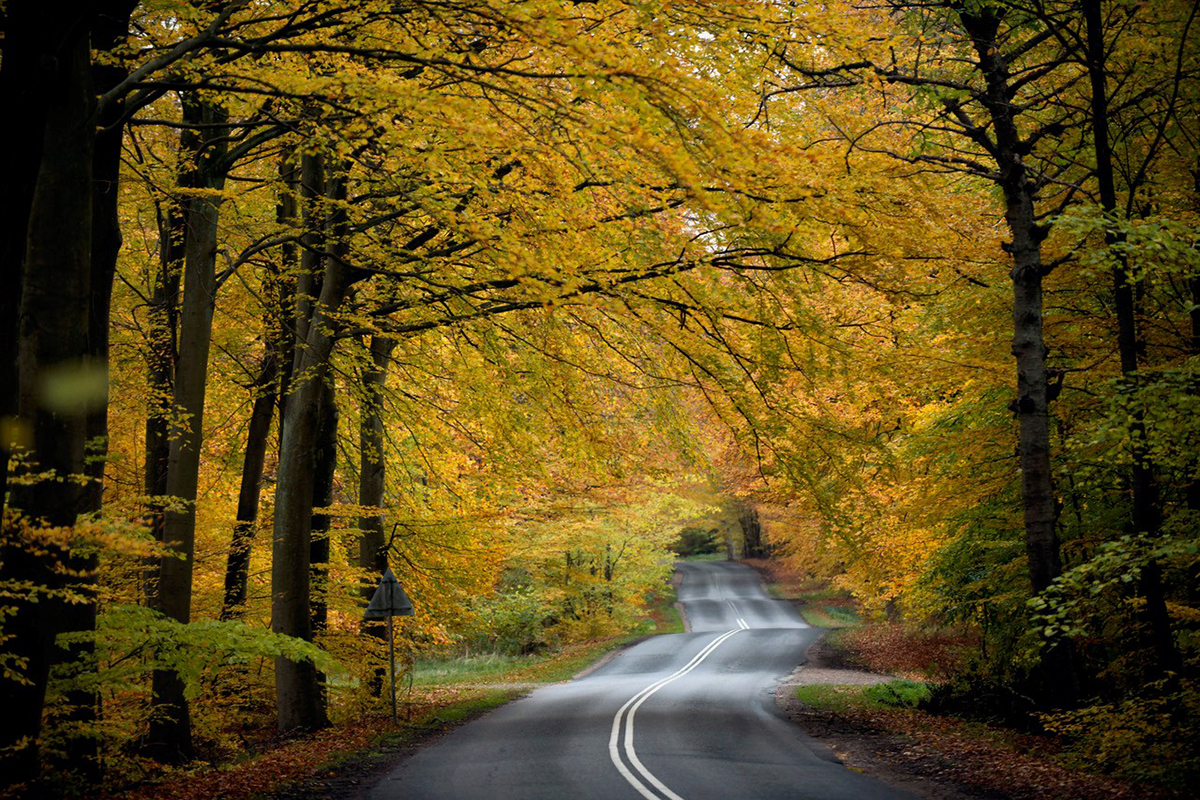Photographing scenic fall drives is a perfect way to capture the rich colors, textures, and moods of the autumn season. As trees turn vibrant shades of crimson and gold, winding roads offer endless opportunities for breathtaking compositions. With the right planning, techniques, and gear—especially Tamron lenses—you can turn a simple drive into a portfolio of powerful seasonal images.

In This Article, You’ll Learn:
- How to plan your drive for peak fall foliage and ideal lighting
- What gear and Tamron lenses to pack for landscape and portrait shots
- Key composition techniques to make your photos stand out
- Tips for capturing people and candid moments during your trip
- How to enhance fall colors naturally in post-processing
Planning Your Scenic Fall Drive for Optimal Photography

The first step in photographing scenic fall drives is planning. Knowing when and where to go can make a significant difference in the quality of your photos.
Peak autumn colors vary by region and year. Generally, they start in the northern regions in early September and move southward through November.
Here are some tips to help you plan your foliage photography road trip:
- Use online foliage trackers to monitor the progress of fall colors.
- Research scenic routes in your area or your intended destination.
- Plan your autumn photography trip around peak foliage for the best color intensity.
- Consider the time of day for optimal lighting conditions.
- Check the weather forecast. Overcast days can provide soft, even lighting, while sunny days can create dramatic shadows and highlights.
The goal is not just to capture beautiful landscapes. It’s also about enjoying the journey and immersing yourself in the autumn beauty. So, take your time, explore different routes, and let nature guide your lens.
Essential Camera Gear for Fall Photography

When it comes to photographing scenic fall drives, the right gear can make all the difference.
- Camera: Your camera is, of course, the most crucial piece of equipment. A camera with manual settings allows you to control the exposure, focus, and depth of field.
- Lenses: Next, consider your lens choice. Tamron lenses are a popular choice for their versatility and quality. For fall foliage photography, a wide-angle lens can capture expansive landscapes, while a telephoto lens can isolate details or compress perspective.
- Tripod: Don’t forget a sturdy tripod. It’s essential for sharp images, especially in low light conditions or when using slow shutter speeds for long exposures.
- Filters: Lastly, consider filters. A polarizing filter can enhance the vibrant colors of fall foliage and reduce glare. Neutral density filters can help manage bright light and allow for longer exposures.
Capturing the Vibrant Colors of Fall Foliage

The fall season is defined by vibrant colors. The autumn palette of reds, oranges, yellows, and browns paint the landscape, creating a photographer’s paradise.
To capture the rich hues of autumn when photographing scenic fall drives, it’s essential to understand how light influences your images. The quality of light can dramatically impact the intensity and mood of fall colors—overcast skies often enhance saturation and reduce harsh shadows, while direct sunlight can flatten tones and wash out vibrant foliage.
Your camera settings also play a role. Shooting in RAW format gives you more control over color adjustments in post-processing. Also, consider using a polarizing filter. It can enhance the colors by reducing glare and reflections.
Composition is another key aspect. Look for contrasts in color and texture. A red maple tree against a clear blue sky, or a carpet of yellow leaves against a dark river, can create striking images.
Capturing the vibrant colors of fall is not just about technical skills. It’s about observing, exploring, and connecting with the landscape. So, take your time, enjoy the drive, and let the autumn colors inspire your creativity.
Composing the Perfect Autumn Shot

Composition is the arrangement of elements in a photograph. It’s how you tell a story, evoke emotions, and guide the viewer’s eye.
- Rule of Thirds: One of the most common composition techniques is the rule of thirds. Imagine dividing your frame into nine equal parts with two horizontal and two vertical lines. Place your main subject along these lines or at their intersections for a balanced and engaging composition.
- Leading Lines: Leading lines are another powerful tool. Roads, rivers, fences, or rows of trees can lead the viewer’s eye into the image. They can create depth, perspective, and a sense of journey, which is perfect for a road trip theme.
- Framing: Don’t forget about framing. Use natural frames like tree branches, arches, or windows to highlight your subject. This can add context, create a sense of depth, and make your subject stand out.
- Angles & Perspectives: Finally, experiment with different angles and perspectives. Shoot from a low angle to emphasize the size of trees, or from a high angle to capture a sweeping landscape. Remember, there’s no right or wrong in composition. It’s all about expressing your vision and creativity.
Overcoming the Challenges of Fall Photography Lighting

Lighting can make or break a photograph. It can transform an ordinary scene into a magical one, or it can wash out colors and create harsh shadows—especially when photographing scenic fall drives.
Overcast days are common in fall, but they can actually be beneficial for photography. They provide soft, diffused light that reduces shadows and brings out the rich tones of fall foliage. Don’t be discouraged by the lack of sunlight. Instead, embrace the moodiness when photographing scenic fall drives to capture the unique atmosphere of the season.
On bright, sunny days, try using a polarizing filter. It can reduce glare, enhance contrast, and make the colors pop. It’s especially effective for blue skies and bodies of water. Remember to adjust the filter by rotating it until you achieve the desired effect.
Lastly, don’t forget about the golden hour. This period shortly after sunrise or before sunset provides warm, soft light that can add a magical glow to your autumn landscapes. It’s worth waking up early or staying out late to make the most of it when photographing scenic fall drives.
Lastly, don’t forget about the golden hour. This period shortly after sunrise or before sunset provides warm, soft light that can add a magical glow to your autumn landscapes. It’s worth waking up early or staying out late for this beautiful light.
The Golden Hour: Making the Most of Autumn’s Best Light

The golden hour is a photographer’s best friend. It’s that magical time when the sun is just above the horizon, casting a warm, soft light that can transform your autumn landscapes.
During this time, the low angle of the sun creates long shadows that can add depth and interest to your compositions. The warm light can also enhance the vibrant colors of fall foliage, making them appear even more saturated.
However, the golden hour doesn’t last long. It’s crucial to plan your shots in advance and be ready to capture the moment when the light is just right. Remember, patience is key in photography.
Lastly, don’t pack up your gear as soon as the sun sets. The period just after sunset, known as the blue hour, can also provide beautiful lighting conditions for your autumn landscapes.
Creative Perspectives in Fall Photography

Autumn offers a wealth of opportunities to get creative with your photography. One way to do this is by experimenting with different perspectives.
For instance, try shooting from a low angle with a wide-angle lens to emphasize the towering height of the trees and the depth of the fall colors. Alternatively, consider using a telephoto lens from a higher vantage point, to capture the compressed layers of the autumn landscape from an aerial view.
Incorporating reflections can also add a unique twist to your fall photos. A macro lens can be particularly useful here, allowing you to focus on intricate reflections in small bodies of water, like puddles or dew droplets, to highlight the vibrant foliage in an unexpected way.
The goal is to show the viewer something they might not see every day. So don’t be afraid to think outside the box, experiment with different lenses, and try something new.
Capturing Companions on a Fall Scenic Road Trip

Capturing your companions during a fall scenic road trip adds a personal and storytelling element to your photography.
As you explore while photographing scenic fall drives, take time to create portraits that blend the vibrant autumn environment with the people you’re with. A wide-angle lens can be great for situating your friends or family within the expansive landscape, emphasizing the connection between them and the stunning fall backdrop. For more intimate shots, a telephoto lens allows you to focus on the emotions and expressions of your companions while softly blurring the surrounding scenery, keeping the attention on them while still hinting at the beautiful environment.

Don’t forget to capture candid moments, like your friends preparing your meal while camping or enjoying a warm drink by the roadside, to truly encapsulate the essence of your fall adventure.
Post-Processing Tips for Enhancing Autumn Colors
Post-processing is a crucial step in bringing out the best in your fall photos. With the right editing techniques, you can enhance the vibrant autumn colors captured with your Tamron lens.
Consider using editing software like Adobe Lightroom or Photoshop. These tools offer features like color grading and selective saturation, which can help emphasize the reds, oranges, and yellows in your images.
The goal is to enhance the natural beauty of the scene, not to create an unrealistic image. So, keep your edits subtle and true to what you saw with your own eyes.
Respecting Nature While Capturing Its Beauty

While on your scenic fall drive, it’s important to respect the natural environment. This means staying on designated paths and not disturbing wildlife or their habitats.
When photographing a road trip in the fall, the beauty of autumn is a gift to be cherished. By respecting nature, we ensure that future generations can also enjoy and photograph these stunning landscapes.
Conclusion: The End of the Road Trip, but Not the Journey
As your time photographing scenic fall drives comes to an end, remember that the journey doesn’t stop here. The skills you’ve honed and the experiences you’ve gained will serve you well in future photography adventures.
With these fall photography tips and your favorite Tamron lens, you’ll return with images that beautifully capture the essence of the season.
